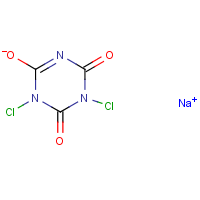Sodium dichloroisocyanurate
Agent Name
Sodium dichloroisocyanurate
Alternative Name
Troclosene sodium
CAS Number
2893-78-9
Formula
C3-H-Cl2-N3-O3.Na
Major Category
Other Uses

Synonyms
Troclosene sodium; 1,3,5-Triazine-2,4,6(1H,3H,5H)-trione, 1,3-dichloro-, sodium salt; 1-Sodium-3,5-dichloro-1,3,5-triazine-2,4,6-trione; 1-Sodium-3,5-dichloro-s-triazine-2,4,6-trione; ACL 60; CDB 63; CP 17254; Dichloroisocyanurate sodium; Dichloroisocyanuric acid sodium salt; Dichlorosymtriazine-2,4,6(1H,3H,5H)trione sodium derivative; Dikonit; Dimanin C; Fi Clor 60S; Isocyanuric acid, dichloro-, sodium salt; OCI 56; SDIC; Simpla; Sodium dichlorisocyanurate; Sodium dichloro-s-triazinetrione; Sodium dichlorocyanurate; Sodium salt of dichloro-s-triazine-2,4,6-trione; Sodium salt of dichloro-s-triazinetrione; s-Triazine-2,4,6(1H,3H,5H)-trione, 1,3-dichloro-, sodium salt; Troclosene sodium; [ChemIDplus] UN2465
Category
Biocides/Disinfectants
Description
White solid with an odor of chlorine; Slightly hygroscopic; [HSDB] Tablets; [MSDSonline]
Sources/Uses
Used as a sanitizing, bleaching, and disinfecting agent (dry bleaches, dishwashing compounds, scouring powders, detergent-sanitizers, food processing, swimming pool disinfectants, and water and sewage treatment); [HSDB] Used in industrial deodorants, non-shrinking treatment of wool, and bleaching of textiles; [CHEMINFO]
Comments
Toxic by ingestion; A strong oxidizer; Fire hazard near organic materials; [Hawley] A strong oxidant that may react violently with combustible substances; Decomposed by water and heat evolving toxic gases including chlorine; A skin, eye, and respiratory tract irritant; [ICSC] A skin, eye, and respiratory tract irritant; [HSDB] A strong oxidizing agent; May react with water producing chlorine gas; A moderate eye irritant; [CAMEO] Forms corrosive hypochlorous acid on contact with moisture from tissue or air; A strong eye and respiratory tract irritant; Highly irritating to broken skin; May cause corrosive skin burns on prolonged contact; Inhalation of high concentrations may result in acute pulmonary edema; [CHEMINFO] A skin and eye irritant; [eChemPortal: ERMA] May explode from shock, friction, or other ignition source; May cause fire on contact with combustible substances; An eye and respiratory tract irritant; [eChemPortal: ESIS] Evolves hypochlorous acid and cyanuric acid on contact with water; A strong eye irritant, based on animal studies; An oxidizing agent; May cause fire on contact with combustible material; An irritant; May cause corrosive injuries; Effects in high-dose animal studies include acute pulmonary edema; [MSDSonline] See "Dichloroisocyanuric acid," "Sodium cyanurate," and "Trichloroisocyanuric acid."
Reference Link #1
Biomedical References
Exposure Assessment
Lethal Concentration
LC50 (rat) < 847.5 mg/m3/4h
NFPA
will not burn
Adverse Effects
Toxic Pneumonitis
Yes
Dermatotoxin
Skin burns
Diseases, Processes, and Activities Linked to This Agent
Processes
Industrial Processes with risk of exposure: